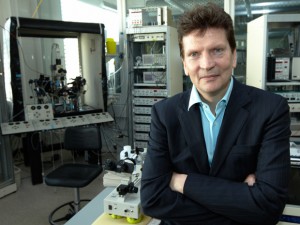 If neuroscientist Henry Markram had a dollar for every neuron he wants to map, he still wouldn’t have enough money.
If neuroscientist Henry Markram had a dollar for every neuron he wants to map, he still wouldn’t have enough money.
As it happens, the Swiss Federal Institute of Technology in Lausanne (EPFL) researcher has a billion euros, or $1.38 billion, from the European Union to spend over the next ten years, but the normal means of determining a neuron’s activity can cost $1 million and take a year. By the time he got through the 3000-odd pathways shown in the photograph of a pinhead-sized slice of brain behind him in a conference room last month, he’d be flat broke, decades older, and he’d still have to map countless more pinheads’ worth of neurons to understand the brain. As Markram has been telling everyone since he got the €1 billion nod to lead the Human Brain Project, the way researchers study the brain needs to change. His approach—and it’s not the only one—stands on an emerging type of computing that he and others claim will let machines learn more like humans do. They could then offer generalizations from what’s known about a handful of neural pathways and find shortcuts to understanding the rest of the brain, he argues. The concept will rely as much on predictions of neural behavior as on experimental observations.
Yet such predictions will have to come from people until they can better train their computers to do it. So-called cognitive computing, which relies on recognizing elements of a familiar thing in new settings, is difficult to achieve through the kind of raw calculation to which most supercomputers are suited. It’s not like winning at chess or even “Jeopardy!”, two tasks IBM machines have mastered. But IBM researchers are already turning Watson, the supercomputer that beat “Jeopardy!”, into a recipe-remixing machine, and they are sure to program it for other tasks that require massive data sifting and some level of semantic analysis.
That’s the direction Markram expects computing to go for biologists, who need their computers to think more like people do. Human intelligence seems to rely on the art of the analogy, as Douglas Hofstadter writes in his new book on artificial intelligence, which James Somers explores at length in The Atlantic this month. That’s why CAPTCHAS have been so hard to defeat: the letters are easy for a computer to learn but difficult to recognize out of context. Yet we can quickly hypothesize what’s important enough about a letter to recognize it when it is distorted.
Markram is counting on those computing capabilities to improve over the course of the project, he says. He’s also counting on being able to persuade his colleagues that such computer-generated hypotheses about neural behavior will be good enough to start making higher-level hypotheses about the brain’s emergent structures. The computer they will use, an updated version of the Blue Brain project’s Swiss-owned IBM Blue Gene, will use a hybrid memory approach, which is handy for keeping massive datasets close to the processors, but it does not yet offer any special artificial intelligence.
In the meantime Markram is focusing his efforts on another kind of computing: cultural. A major element of the Human Brain Project is the ability to unite researchers around common problems and share questions, findings, and interpretations: “we’re basically layering social networking on top of neuroscience,” Markram says.
But he will have a lot of persuading to do. One colleague told The Observer; “whatever your take is on Big Neuro, do not expect them to make good on all their promises to find causes, let alone cures, for any of the big neuro diseases they list in 10 years, and as for new computing technologies? They are pulling your leg.”
To his credit, Markram did not oversell cures to diseases during a conversation with journalists earlier this month shortly after the project’s formal launch. He also gave a realistic reply to a question about whether cognitive findings from the brain project could change the way supercomputing is done: the short version is “not yet.”
Instead, the remarkable thing about the Human Brain Project may not be its computing power so much as its convening power. The social networking layer, Markram says, “is designed for tens of thousands of scientists to be able to collaboratively work on unifying all the knowledge that we have about the brain.”
First published in IEEE Spectrum’s Tech Talk blog: [html] [pdf]